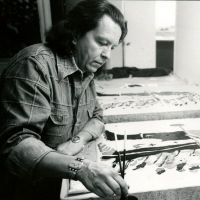Fritz Scholder
Luiseño (Payómkawichum) - American
b. October 6, 1937, Breckenridge, Minnesota —
d. February 10, 2005, Scottsdale, Arizona
Lived and worked in Scottsdale, Arizona
fritzscholder.com
Controversial and prolific, Fritz Scholder embraced paradox. An enrolled member of the Luiseno tribe, he often said he was not Indian. Scholder's works were immediately recognized for their insight and powerful commentary on publicly held stereotypes of Native Americans, thus propelling Scholder into a position of prominence as an artist.
A trailblazer in contemporary Native American art, Scholder redefined Indigenous representation in the visual arts by challenging romanticized and stereotypical portrayals. His breakthrough came in the late 1960s with the “Indian” series, in which he depicted Native figures drinking beer, riding motorcycles, and navigating urban life—scenes that were both provocative and powerfully honest.
His revolutionary paintings broke away from stereotypical roles and forever changed the concept of Indian artist. His style is well known for its distortions, explosive brushwork and vivid colors.
Fritz Scholder's constant desire to explore, collect, travel and experience is undoubtedly the distinguishing feature of both his life and his art.
Scholder’s work combined Abstract Expressionist techniques with Pop Art aesthetics, creating a style all his own. He taught at the Institute of American Indian Arts in Santa Fe, where he mentored a new generation of Native artists. Over his career, Scholder exhibited widely, including at the Smithsonian Institution, and remains one of the most influential figures in Native and American art history.


Indian with Pistol, 1978
lithograph in colors on Arches paper
22 1/2 x 29 3/4 in
Edition of 150 + 7 AP (#54/150)

